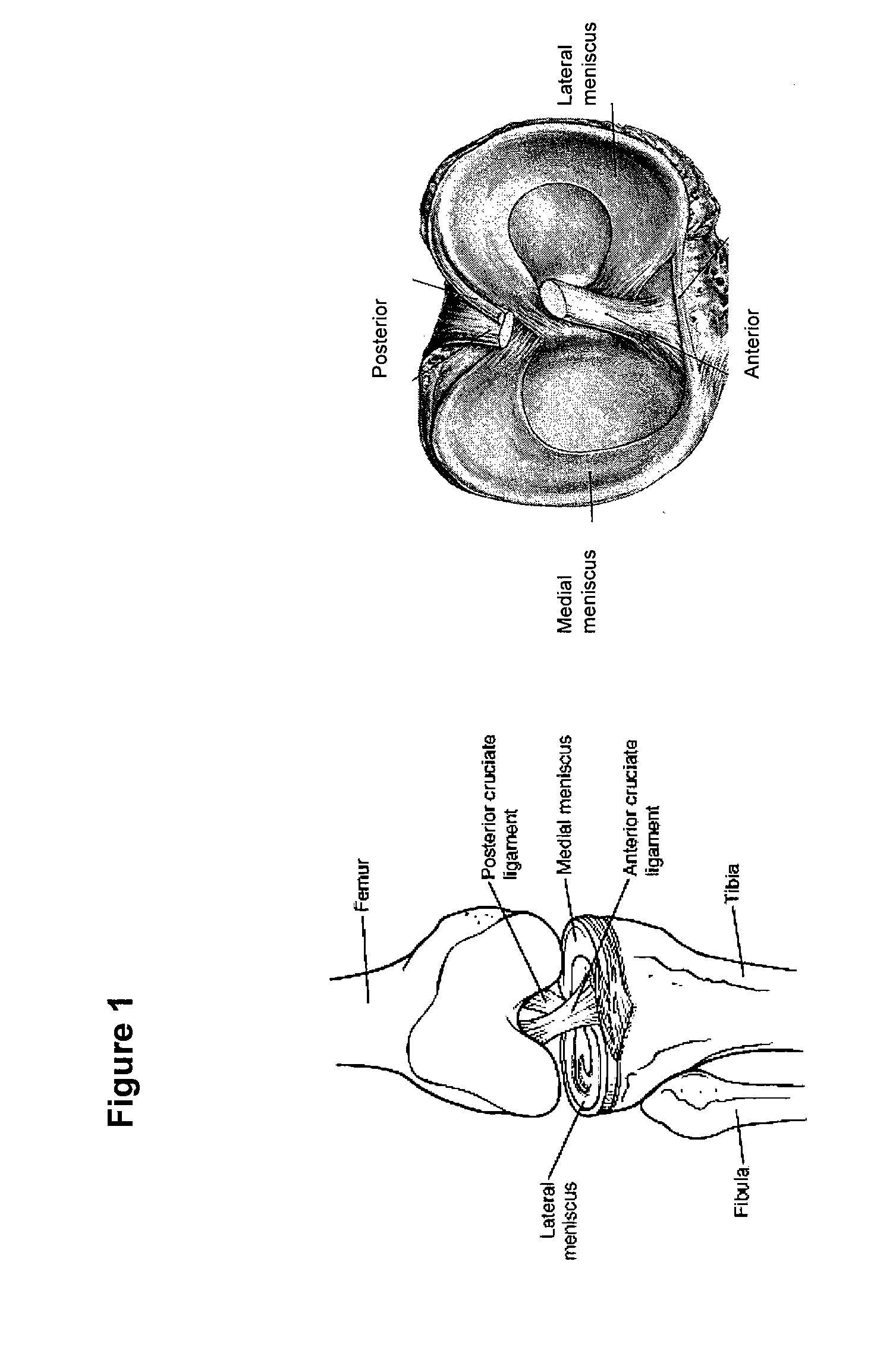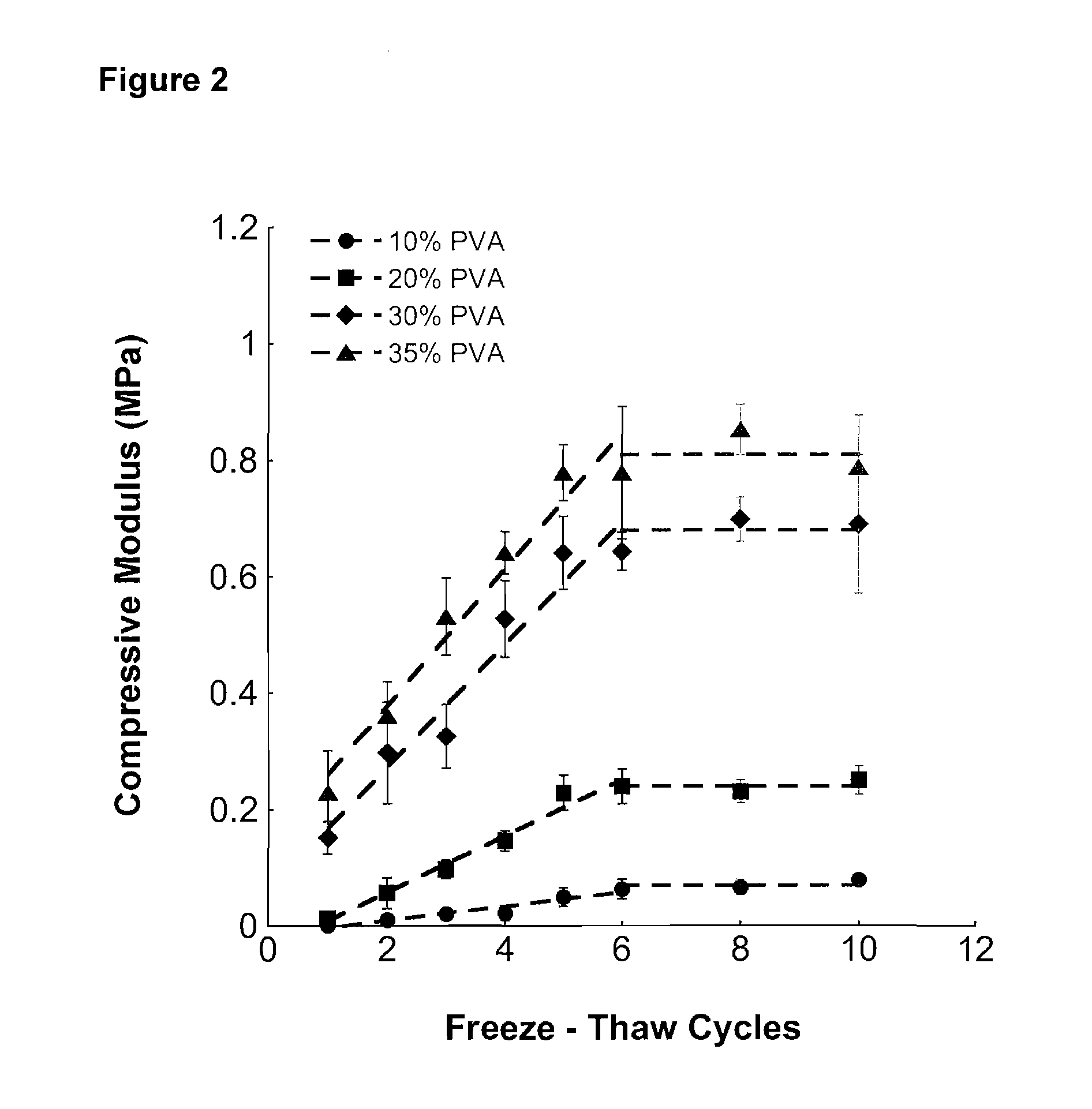Fiber-Hydrogel Composite for Tissue Replacement
a fiber-hydrogel and tissue technology, applied in the direction of prosthesis, ligaments, impression caps, etc., can solve the problems of meniscus not being able to withstand the mechanical burden placed on, affecting the healing effect of the meniscus, and affecting the healing effect of the bone marrow, so as to achieve the effect of minimizing the swelling of the composi
- Summary
- Abstract
- Description
- Claims
- Application Information
AI Technical Summary
Benefits of technology
Problems solved by technology
Method used
Image
Examples
examples
[0067]The invention is now described with reference to the following Examples. These Examples are provided for the purpose of illustration only, and the invention is not limited to these Examples, but rather encompasses all variations that are evident as a result of the teachings provided herein.
[0068]The materials and methods employed in the experiments and examples disclosed herein are now described.
PVA Hydrogel Synthesis
[0069]PVA (99+% hydrolyzed), with a molecular weight of about 89,000-98,000 g / mol, and poly(vinyl pyrrolidone) (PVP), with a molecular weight of about 40,000 g / mol, were obtained from Sigma Aldrich. PVP was added in small amounts to the hydrogel formulation to improve network stability through interchain hydrogen bonding [Thomas et al., 2003, J Biomed Mater Res A. 67(4):1329-37]. Polymer solutions were prepared by mixing about 10 to 20 wt % polymer, composed of approximately 99 wt % PVA and 1 wt % PVP, in deionized water. The container was sealed and autoclaved at...
example # 1
Example #1
PVA Hydrogel
[0083]Compressive and tensile testing was performed on PVA hydrogels synthesized from one to ten freeze-thaw cycles. As depicted in FIG. 2, compressive modulus values were calculated as the average slope of the stress-strain curves between 1% and 5% strain. For all PVA concentrations, linear trends in modulus were observed through the first six freeze-thaw cycles. After six cycles, the compressive modulus did not increase significantly (p<0.05), and reached a plateau value. Also depicted in FIG. 2 are trend lines representing the best fit through the first six freeze-thaw cycles and the average modulus within the plateau region. Polymer concentration had a significant effect on compression modulus (p<0.05). Notably, the compressive modulus for 20 wt % PVA is within the range of the native meniscus, which has an aggregate compressive modulus of 0.22 MPa [Almarza et al., 2004, Ann Biomed Eng. 32(1):2-17].
[0084]Tensile modulus values were also calculated as the av...
example 2
Fiber Reinforced PVA Composite
[0089]Tensile testing was performed on PVA hydrogels reinforced with polypropylene and UHMWPE fibers. Tensile modulus values were calculated from the average slope of the linear region in the stress versus strain curve. Depicted in FIGS. 7 and 8 are plots of tensile modulus as a function of fiber volume fraction (Vf) for polypropylene and UHMWPE fiber-reinforced hydrogels, respectively. Linear increases in modulus as a function of fiber volume fraction were observed in both cases, for the range of Vf examined. PP-PVA composites showed an increase in modulus from about 0.23±0.02 MPa for neat PVA to about 8.2±0.6 MPa at 10% Vf polypropylene. Reinforcement with UHMWPE fabrics resulted in a tensile modulus of about 90.6±21.6 MPa to 258.1±40.1 MPa at volume fractions of approximately 10% and 29% UHMWPE, respectively. UHMWPE-PVA composites exhibited similar tensile stiffness to that seen in the native meniscus in the circumferential direction, which is about ...
PUM
 Login to View More
Login to View More Abstract
Description
Claims
Application Information
 Login to View More
Login to View More - R&D
- Intellectual Property
- Life Sciences
- Materials
- Tech Scout
- Unparalleled Data Quality
- Higher Quality Content
- 60% Fewer Hallucinations
Browse by: Latest US Patents, China's latest patents, Technical Efficacy Thesaurus, Application Domain, Technology Topic, Popular Technical Reports.
© 2025 PatSnap. All rights reserved.Legal|Privacy policy|Modern Slavery Act Transparency Statement|Sitemap|About US| Contact US: help@patsnap.com



